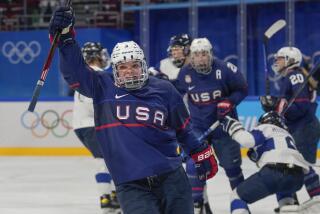California Cool With Hot Wheels : Bogoyevac Makes Switch From Ice to Roller Hockey for L.A. Blades
- Share via
Steve Bogoyevac has spent most of his life trying to escape the image of the “California hockey player.”
There were the training camps in Canada and Minnesota. The two years of junior hockey in South Dakota. The four years of college hockey in Alaska, and a season with a minor league team in Ohio, where ice hockey is serious business. But now, Bogoyevac, 25, has returned home and he’s embraced a part of California culture that he had turned his back on. He’s traded in his ice skates for roller blades.
Welcome back to California.
Bogoyevac, a 1986 Newbury Park High graduate, is the captain of the newly formed Los Angeles Blades, a professional roller hockey team that plays in the Forum. Twelve teams--in cities ranging from San Diego to St. Louis to Toronto--are playing in the inaugural season of the Roller Hockey International league.
Roller hockey rules are similar to ice hockey, with minor differences: There are only five players on the floor, the blue line is eliminated, and there are four 10-minute quarters. Players use the same size rink as regular ice hockey, with either a smooth concrete or dense rubber surface. So shouldn’t it be easy for an experienced ice hockey player such as Bogoyevac to make the transition to roller hockey?
Sure, if he only knew how to skate. Bogoyevac, true to his “not-a-hockey player-from-California” form, had never skated on in-line roller blades until his first day of Blades practice.
“If you ask anyone else on the team about how I looked the first couple of days I was out there . . . ,” Bogoyevac began, and then shook his head and laughed. “I was twisting my ankles and falling down and I just wanted to do everything I do on the ice. But I couldn’t think like I was on wheels.”
Blades Coach John Black describes it a bit differently.
“The first time I saw him and I watched him skate, I thought, ‘Oh my God,’ ” Black said. “From the waist up, he was a great hockey player, but from the waist down, he was useless.
“Right before we were going on our first road trip to Vancouver and Oakland, I pulled him aside and said, ‘I’m going to gamble and take you on the road trip, but right now I’m not sure that you’re going to play because you can’t skate.’
“(But) it was like he woke up the next day and he could skate. I don’t know what happened. I swear it was overnight and he could skate.”
Since waking up to roller hockey, Bogoyevac has played a large role in leading the Blades to a 4-1 record. He is tied for second in team scoring with 18 points (eight goals, 10 assists) and he ranks fifth in league scoring. Bogoyevac (pronounced Bog-EY-a-vis) was injured by a cross-check into the boards in a July 10 game against the San Diego Barracudas and is expected to miss two weeks with a bruised neck.
“He’s a very smart player, a terrific leader, and we count on him for a lot of things, both on and off the floor,” Black said. “I put him out (on the floor) a lot. He always comes through when we need it.”
Like many of the other players in the league, Bogoyevac looks at roller hockey as a steppingstone to professional ice hockey. And even though he’s perfected his in-line skating, the left-handed forward admits that roller blades still give him problems.
“I still don’t know what wheels to use,” he said, referring to the way players use different wheels for different types of surfaces. “We’ve got some guru, and we all just kind of watch what he does. (We say), ‘Oh, he’s got the orange ones on! Put the orange wheels on!’ ”
Bogoyevac’s success with roller hockey is firmly rooted in his experience on the ice. His father took him to his first Kings game when he was 3. By 4, he had a stick in his hands, and a year later he was ice skating with full gear. He progressed quickly, and began playing in a number of leagues with older and bigger kids, his father said.
“When he was 6, he was playing with 11-year-olds, and when he was 11, he was playing with the 17-year-olds,” Walter Bogoyevac said. “He didn’t care about the size and the age, he was always ready to play.”
Some ice hockey players in California who hope to get a college scholarship choose to attend high school in Midwestern states like Minnesota or Wisconsin, where college recruiters are more likely to notice their talents. But Bogoyevac, who lived in Newbury Park since he was a kid, opted to stay at Newbury Park.
Not surprisingly, he wasn’t recruited for a college scholarship. But a coach at a junior hockey camp noticed his talents, and Bogoyevac was selected to play for the United States Hockey League junior team in Sioux City, S.D.
After one season in Sioux City, United States International University in San Diego offered him a scholarship to play for its Division I hockey program.
“I didn’t want to go there cause I grew up in California and I wanted to get away from being a California hockey player,” Bogoyevac said. “A lot of the guys with the same skills as me were going further cause they weren’t from California.”
He turned down the scholarship and played a second season of junior hockey. He was teaching at a hockey camp in Minnesota late in the summer of 1988 when he got a call from a University of Alaska coach, who offered a full scholarship. Bogoyevac left for Alaska the next day.
Bogoyevac finished No. 6 on the Seahawk all-time scoring list with 146 points during his four seasons. He also finished No. 3 with 96 assists and No. 11 with 50 goals. He played in 139 games--the most ever by a Seahawk--and had the most game-winning goals (10) in school history.
He is four classes shy of a bachelor’s degree in management, but instead of returning to school last fall, he pursued his ice hockey career. He was invited to the Kings’ training camp as a free agent, but was released near the end of camp.
“The worst part about it is to get a little taste of what it is like to be at that level, and that just makes you want it that much more,” he said. “After I got released, I wasn’t devastated or anything, but it made me realize that’s where I wanted to be. I saw what kind of players were there and I realized myself that I could definitely play at that level. It’s just a matter of getting into the right place at the right time.”
He joined the Dayton Bombers, a professional minor league team in the East Coast Hockey League, for the 1992-93 season. He scored 30 goals and had 30 assists in 60 games. He returned to California when the season ended in March.
“Now it’s time for me to come back home,” he said. “I’ve been away for a long time and hockey is growing in California enough where--thanks to Gretzky--I’m proud to be from here and be a hockey player.”
He returned to California at the same time that coaches were recruiting minor league and college ice hockey players for the new roller hockey league. After offers from teams in Anaheim and Oakland, Bogoyevac--who, like most people, knew next to nothing about the league or the game--opted for the Blades.
And, like most of the other ice hockey players who were recruited for the sport, Bogoyevac was forced to adjust quickly--both his attitude and his playing style.
“I had said to my mom, ‘I’m just going to be a bench warmer and watch the game and have a good time,’ ” Bogoyevac said. “But after the first week of practice I could tell it wasn’t going to be like that. And after the first game, I could tell it was serious.
“It’s serious enough that there’s a lot of money to be made here. It could grow to be a great sport, but at the same time I’m kind of leaning toward playing professional ice hockey. In a way, it’s like a summer job to me, and I’m having lots of fun doing it.”
But make no mistake about it, if Bogoyevac had an offer from a minor league or National Hockey League team, he’d return to the ice in an instant, even if it meant giving up roller hockey.
“It seems like right now, they’re (arranging the roller hockey schedule) so it’s not the same season as ice hockey,” he said. “So in a sense, I could almost do both. I have a great time doing it and I get paid, so what better way to spend a summer?”


